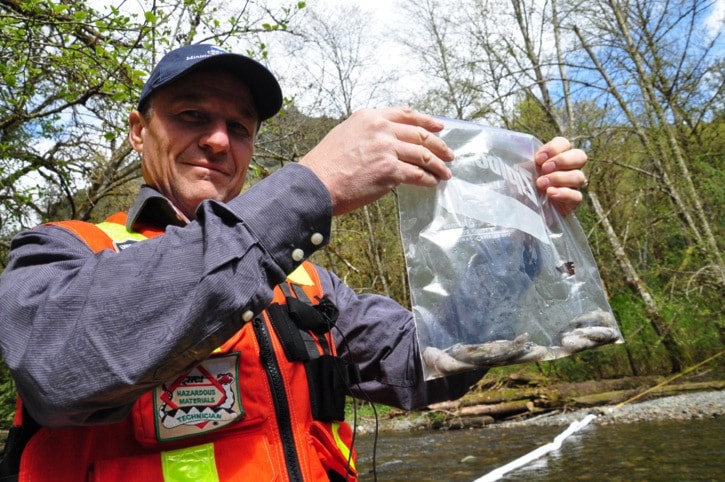Stand long enough next to Goldstream River and the gasoline smell will eventually burble to the surface.
More than a week after a Columbia Fuels tanker crashed and spilled nearly 42,000 litres of gasoline into the river, residual fuel remains glued to stones in the water. Dead salmon fry are visible from the riverbank.
“There’s lots of dead sculpin today,” remarked Laurie Boyle, an emergency planning response officer with the Ministry of Environment, holding a plastic bag with half a dozen small fish.
Absorbent booms are strung across Goldstream River near Finlayson Arm Road to catch gasoline residue slowly making its way to the surface. A majority of the fuel — 600 litres of it was also diesel — flowed into the Goldstream estuary and evaporated last weekend, but traces remain on rocks or absorbed into soil and stream side vegetation.
Graham Knox, manager of the environmental emergency program with the Ministry of Environment, said over the next days and weeks, ministry staff, First Nations and other agencies will try to quantify damage done to the river ecosystem.
“All agencies and First Nations will contribute. We want to get a good picture of the full range of damage,” Knox said. “We need to determine what Columbia Fuels is responsible for remediating.”
Knox and fisheries biologists with Tsawout First Nation reported last week that thousands of juvenile chum and coho died in the initial wave of gasoline. Now they need to determine if fish are returning to the main channel and if residual fuel is linked to further deaths.
“Some (salmon) may have moved up a side channel and are now moving back,” Knox said. “We’re looking for new mortalities from material trapped under cobbles. But every hour, every day (the fuel) breaks down more.”
Determining the extent of the damage is a difficult question, and bringing the ecosystem back to full health, if possible, will be delicate balance between remediation and letting nature do the work.
Knox said there could be habitat restoration projects and work with the Goldstream hatchery to release more fish, but environmental officers want to avoid coming at the river with a heavy hand.
“We aren’t going to be raking the entire river,” he said. “Some solutions are more damaging and invasive.”
Knox agreed the fuel spill in Goldstream River is a disaster for the ecosystem and people who depend on the river for food, but to what extent will be determined by research and monitoring.
“For the First Nations people who rely on chum for food and cultural uses, it is a disaster. For the hatchery (volunteers) who put all this effort into making this a productive stream, it’s a disaster,” Knox said. “For the fish it’s a disaster. To what extent is to be determined.”
At the Goldstream Nature House, park naturalist Bre Statham said the phone has been ringing off the hook from people wanting to help clean up the river.
“People call and say ‘I’ve got my gum boots, what can I do?’” she said. “Unfortunately letting the public in the river would do more harm than good, but the community support is amazing. So many people are passionate about the river.”
First Nations left in the dark after fuel disaster
First Nations chiefs gathered at Goldstream River Thursday and blasted the federal and provincial governments for leaving them out of the communications loop after the April 16 fuel spill.
Five First Nations — Tsartlip, Tsawout, Pauquachin, Tseycum and Malahat, representing about 3,000 people — catch thousands of fish each year for food and ceremonial purposes from the Goldstream River system. Offering a joint call for action, the five say they have an moral and legal right to be involved in how the river system is restored to health.
“Our people rely on the stream year after year. But now that this has happened, it’s become something of a dead water for us,” said Tsartlip Chief Ivan Wayne Morris. “Even though you see the water running, there’s nothing alive in it.”
Morris said the government didn’t bother to communicate with the five First Nations that surround the stream, despite the local expertise on working within the river system.
“There were numerous ministries involved here. Not one took the opportunity to come and talk to us. Not one,” Morris said.
“(The spill is) a real devastation to our children, our elders and our community. We want to be involved every step of the way.
“We’d like to see restoration, we’d like to see it brought back to what it was before,” he continued. “We’re looking at what’s not going to be there for us in the next few years. When we came down here that day (April 17) there was absolutely nothing swimming around.”
The five First Nations had a meeting with Columbia Fuels on Thursday, although he said no specifics were promised other than to keep working together.
Tsawout fisheries manager Dan Claxton agreed that better communication could have allowed for a broader response to contain the spill in the Goldstream estuary, while emergency crews dealt with the tanker crash on the highway.
“(Department of Fisheries and Oceans) have teams ... that could have been down here with us helping us contain the spill,” Claxton said. “There is a definite disconnect there.”
Ian Bruce, a fisheries biologist with Tsawout, said on Thursday he was seeing fewer new dead fish, but only time will tell the ultimate toll.
“One of the questions we want to have answered is what is left in terms of fish resources?,” Bruce said. “There is obviously some fish still alive, but what species and how many? Why are they still alive and so many others died?”
editor@goldstreamgazette.com
